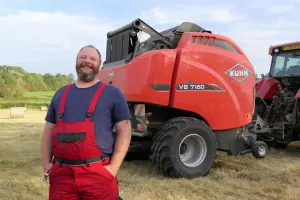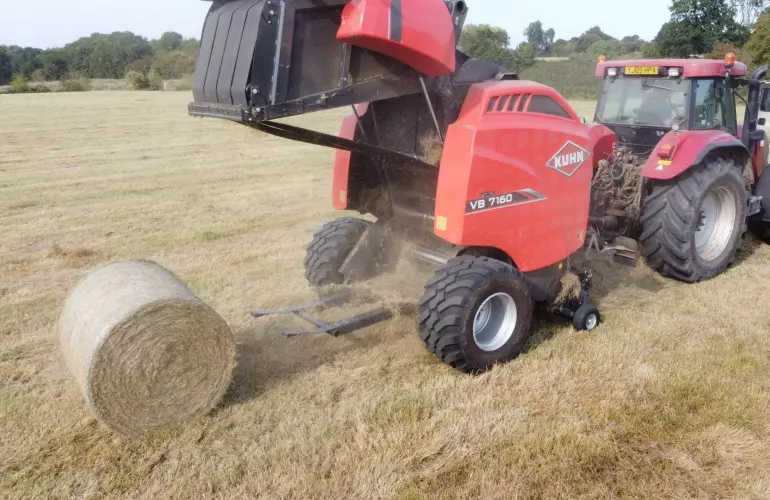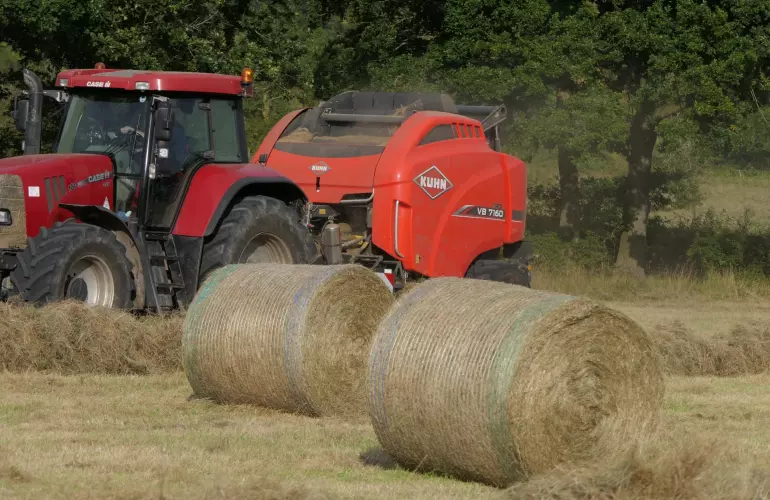Baler Technology Meets Varying Demands
Operating as W. Johnson and Sons, Dave runs his own beef and arable farm and a contracting business that offers hedge cutting, silage making, muck spreading and arable cultivations, as well as baling everything from silage to straw. As a contractor, he is used to dealing with a range of crop types and conditions and understands the importance of giving the customers what they want.

When Warwickshire farmer and contractor Dave Johnson decided to replace his two variable chamber round balers with a single machine, strength and reliability were amongst his top priorities.
He was also focused on performance, both in terms of output and the ability to consistently produce tightly packed square-shouldered bales, whether working in silage, haylage, hay or straw.
After looking at several options, he ultimately settled on the Kuhn VB 7160 variable chamber baler. Twelve months on, he feels fully vindicated in his choice of machine, and in his decision to rely on a single round baler across his business.
“The first thing I noticed at the demonstration was the rapid cycle time of just four seconds from bale ejection to the door closing again, which has a big impact on the number of bales per hour,” recalls Dave.
“I was also impressed with the build quality, with key components such as the chains, bearings and rollers being so much heavier than I’ve seen on other machines. It really looks like it has been built to last, which is exactly the reassurance you need when you have contracting commitments as well as your own baling to think about.”
Catering for demands
Operating as W. Johnson and Sons, Dave runs his own beef and arable farm and a contracting business that offers hedge cutting, silage making, muck spreading and arable cultivations, as well as baling everything from silage to straw. As a contractor, he is used to dealing with a range of crop types and conditions and understands the importance of giving the customers what they want.
The VB 7160 is part of a range of balers launched in 2020, which feature Kuhn’s patented I-Dense system that enables bale densities of up to 140kg/m3. Through this automated system, bale pressure is adjusted in response to moisture levels monitored by the integral sensor, so requires no operator control to deliver fast and consistent bale formation in a wide range of conditions.

“I find the moisture sensor is very accurate when checked against a handheld probe,” adds Dave. “The automated bale pressure adjustment means there’s no risk of packing bales too tightly, which helps avoid sweating and the risk of mould.”
Dave’s VB 7160 is the Opti-Cut model, with the option of 14 knives that he uses mainly for baling silage, a feature that he believes is a major advantage when it comes to forage quality and feeding efficiency.
“The knives chop the grass very efficiently, which helps produce an evenly compacted and well-made bale. This is not only making a better-quality silage, but results in less waste during feeding.”
Operational capacity is estimated at around 30t/hour, according to Kuhn, and that sits comfortably with Dave Johnson’s own experience. He reckons 50 bales/hour is easily achievable in a crop of hay or straw, when he’d expect to be travelling at about 8kph.
“I’m often baling behind an eight-metre rake, so the intake performance is very good,” he adds.
“I’ll obviously be travelling slower when baling silage, with the knives in operation, but the output is still impressive. Bale density is certainly right up there, with silage bales up towards a tonne in weight.”
Smooth crop flow
The VB 7160 has a 2.3m pick-up width, with its intake performance facilitated by Kuhn’s patented Integral Rotor system that has become a key feature on all its modern balers.
“The consistent flow of crop into the baler is a major advantage,” says Dave. “On the rare occasion when there is a blockage, the hydraulic drop floor function makes it a simple and easy operation to get underway again. There are no stub augers either, which eliminates product gathering on the ends and then going through as a lump. It just has a constant feed.”

With extra dense bales to contain, Dave finds that two and a half layers of net are the optimum for the smallest diameter bales with this increasing to three and a half layers for the maximum (160cm) size. Changing the net rolls is very quick and simple, with no tools required.
The VB 7160 is ISOBUS compatible, though Dave runs his machine with Kuhn’s own VTI 60 terminal in his cab. This provides all the required operational information, such as bale density, bale size and bale counts, and alerts him when it is time to grease the machine.
“There is the option of automated greasing, but I prefer to use a grease gun myself as then I can be fully confident that the job has been done,” he adds. “It’s also a good discipline to have a daily check of the belts and chains, which I do when greasing round.
“I’ll expect to be baling somewhere between 8,000 and 10,000 bales in a season, of all crop types and bale sizes. The important thing is to be able to bale and bale and bale, with no downtime, and my experience with this machine so far has been exactly that.”
